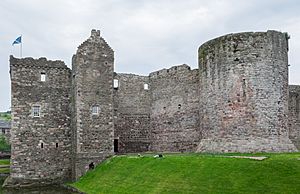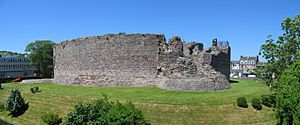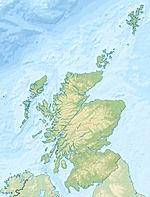Rothesay Castle facts for kids
Quick facts for kids Rothesay Castle |
|
|---|---|
| Rothesay, Isle of Bute, Scotland | |

Rothesay Castle, with the 16th century forework in the centre, and the 13th century "Pigeon Tower" on the right
|
|

The 13th century curtain wall seen from the south-east, across the moat. The bases of the south-east and south-west towers can be seen.
|
|
| Coordinates | 55°50′11″N 5°03′18″W / 55.836461°N 5.055041°W |
| Type | Curtain Wall and Moat |
| Site information | |
| Owner | Historic Scotland |
| Controlled by | House of Stuart |
| Open to the public |
Yes |
| Condition | Ruined |
| Site history | |
| Built | 13thC |
| Built by | Alan, High Steward of Scotland or Walter Stewart |
| In use | Until 1660 |
| Materials | Stone |
Rothesay Castle is an old, ruined castle in Rothesay, the main town on the Isle of Bute in western Scotland. It is known as "one of Scotland's most amazing castles" because of its long history and unusual round shape.
The castle has a huge round wall, called a curtain wall. Four strong round towers make it even tougher. There's also a 16th-century gatehouse, and a wide moat surrounds the whole castle. The Stewart family built it. It survived attacks from Vikings and became a home for kings. It became a ruin after the 1600s, but the Marquess of Bute fixed it up. Now, the Scottish government looks after it.
Contents
Building the First Castle
The castle was built by either Alan fitz Walter or his son Walter. They were powerful leaders in Scotland. The Stewart family added the Isle of Bute to their lands around this time.
At first, there was a wooden castle. But by the 1230s, a strong stone wall was built. This round stone wall was attacked by a Viking fleet in 1230. The Vikings were led by Óspakr-Hákon, King of the Isles.
Viking Attacks and Battles
An old Viking story, Hákonar saga Hákonarsonar, tells us about the attack. Óspakr's forces fought for three days to take the castle. They even chopped at the stone wall with their axes until part of it broke! This is the first time an attack on a Scottish castle was written down.
In 1263, Rothesay Castle was attacked by Vikings again. This time, Hákon Hákonarson, King of Norway led the attack. This happened just before the Battle of Largs. Even though the battle didn't have a clear winner, King Hákon's plan failed. This ended Viking power in western Scotland.
The Castle's Original Design
The first castle was just a round stone wall. It was about 2.7 meters (9 feet) thick and 7.9 meters (26 feet) high. The wall was about 42 meters (138 feet) wide. It stood on a small hill.
The top of the wall had battlements, which are gaps for defenders to shoot through. You could reach them by open stairs. The moat around the castle was connected to the sea. The sea used to be much closer to the castle than it is today.
The wall had only two openings. The main gate was an arch with a simple wooden door. There was also a small back gate on the west side, but it was later blocked up.
Adding Towers and Defenses
Later in the 1200s, the castle became even stronger. Four round towers were added to the wall. Today, only the north-west tower is still complete. These towers had three floors and strong, wide bases. They had narrow openings for archers to shoot arrows.
A portcullis was also added to the main gate. This was a heavy metal or wooden gate that could be lowered quickly to block the entrance.
Royal Connections and Sieges
During the Wars of Scottish Independence, the English held Rothesay Castle. But Robert the Bruce took it back for Scotland in 1311. It fell to the English again in 1334, but the Scots soon captured it once more.
A Royal Home
When the Stewart family became kings of Scotland in 1371, Rothesay Castle became a favorite home. Kings Robert II and Robert III loved staying there. King Robert III even died at the castle in 1406.
Robert II gave his son John the job of looking after the castle. John's family later became the Earls and Marquesses of Bute. In 1401, Robert III made his oldest son David the Duke of Rothesay. This started a tradition. Since then, the person who will become king or queen of Scotland is often given the title Duke or Duchess of Rothesay.
In 1462, the castle survived another attack. John of Islay, the last Lord of the Isles, tried to capture it, but he failed.
Changes in the 1500s and 1600s
In the early 1500s, Rothesay Castle was made even stronger. A new gatehouse, called a "forework," was built. It stuck out from the north side of the main wall. This new part was started around 1500 for King James IV. It gave the king more modern rooms to live in.
The main castle wall was also made taller, reaching up to ten meters (33 feet) high. This work continued when King James V was on the throne. In 1527, the castle survived another attack. This time, the Master of Ruthven tried to take it, and much of the town of Rothesay was destroyed.
The Forework and Pigeon Tower
In 1544, the castle was captured by the Earl of Lennox. He was working for the English during a time called the "Rough Wooing".
The forework is shaped like an 'L'. It reached into the moat and had a drawbridge to get across. The bottom floor had a long, arched tunnel that led into the old castle courtyard. Above this, the four-story tower had rooms for the royal family. You can still see the royal coat of arms above the door.
Around the same time, a chapel was built inside the old castle. It was a simple building, about 7 meters (23 feet) by 13.7 meters (45 feet). It is the only building left inside the main castle wall today. The north-west tower was turned into a doocot, which is a place for pigeons to live. It's now called the "Pigeon Tower" because of the pigeon nests built into its outer wall.
Castle Falls into Ruin
Rothesay Castle was used by Oliver Cromwell's soldiers. They invaded Scotland in the 1650s. When they left in 1660, they partly broke down the castle. What was left was burned in 1685. This happened during a rebellion led by Archibald Campbell, 9th Earl of Argyll. He was fighting against King James VII.
Bringing the Castle Back to Life
After many years of being left alone, the castle was in bad shape. But in 1816-17, the 2nd Marquess of Bute hired 70 men to dig out the ruins. They cleared away lots of rubbish from the castle.
Work on the castle started again in 1871. The 3rd Marquess of Bute loved fixing old buildings. He began a big project to repair and restore the castle. He got advice from his architect, William Burges. His "restorations" continued until 1900. During this time, the moat was cleared and shaped. Red sandstone was added to the forework, fixing the roof of the hall. These changes made the building look quite different.
In 1961, Rothesay Castle was given to the Scottish government. It is now a Scheduled Ancient Monument. This means it is a very important historical site. Historic Scotland looks after it.
The castle is open to visitors all year. You can get great views from the top of the walls. You can see the town and look back towards the mainland.
Images for kids




